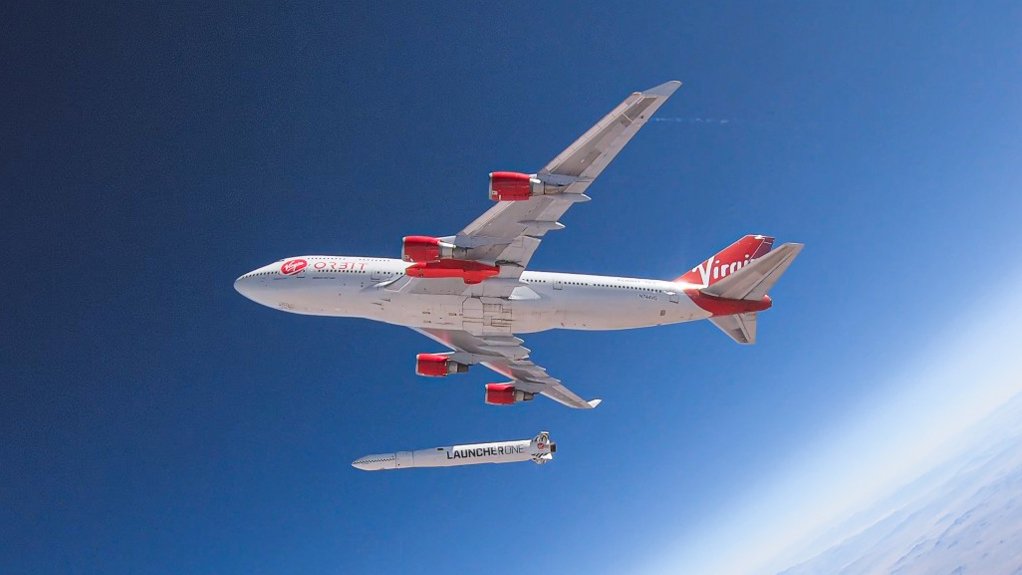First space orbital launch from UK reaches orbit, but the wrong orbit


The LauncherOne rocket falls away from its carrier aircraft, Boeing 747 Cosmic Girl
Photo by Virgin Orbit
The first attempt to place satellites into orbit from the UK – indeed, from any place on the European continent outside of Russia – saw the launch vehicle enter orbit but fail to achieve the correct orbit, making the mission a failure. The launch was made in the early hours of Tuesday morning, South African time, and executed by US company Virgin Orbit (whose majority shareholder, however, is famed UK entrepreneur Sir Richard Branson).
Virgin Orbit specialises in horizontal launches. That is, the company’s space rocket, designated LauncherOne, is carried aloft on a pylon mounted on a modified Boeing 747 airliner (named Cosmic Girl). At an altitude of about 10 600 m, the LauncherOne is released by the aircraft, drops away and, at a safe distance, ignites its rocket motor and zooms up into space. LauncherOne is a two-stage rocket, with the upper stage being responsible for deploying the satellites in their correct orbit.
The base for this launch mission was Spaceport Cornwall, located at Newquay, on the northern coast of the county of Cornwall, which is a peninsula in the far southwest of England. The Spaceport shares a runway with Newquay airport. The launch mission was a joint project of the UK Space Agency, the UK Royal Air Force, the UK Civil Aviation Authority, the US Federal Aviation Administration and the US National Reconnaissance Office, among others. The mission was to deploy nine small satellites.
According to Virgin Orbit, Cosmic Girl successfully executed her part of the mission, releasing the LauncherOne rocket at launch altitude. The first stage of the rocket then ignited its engines, and soared into space, according to plan. The second stage then successfully separated from the first stage and ignited its engine. But, in the words of the company, “at some point during the firing of the rocket’s second stage engine and with the rocket travelling at a speed of more than 11 000 miles per hour [17 700 km/h], the system experienced an anomaly, ending the mission prematurely”.
"While we are very proud of the many things that we successfully achieved as part of this mission, we are mindful that we failed to provide our customers with the launch service they deserve,” said Virgin Orbit CEO Dan Hart. “The first-time nature of this mission added layers of complexity that our team professionally managed through; however, in the end a technical failure appears to have prevented us delivering the final orbit. We will work tirelessly to understand the nature of the failure, make corrective actions, and return to orbit as soon as we have completed a full investigation and mission assurance process.”
“Virgin Orbit attempted the first orbital launch from Spaceport Cornwall,” highlighted UK Space Agency Commercial Spaceflight director Matt Archer. “We have shown the UK is capable of launching into orbit, but the launch was not successful in reaching the required orbit. We will work closely with Virgin Orbit as they investigate what caused the anomaly in the coming days and weeks. While the result is disappointing, launching a spacecraft always carries significant risks. Despite this, the project has succeeded in creating a horizontal launch capability at Spaceport Cornwall, and we remain committed to becoming the leading provider of commercial small satellite launch in Europe by 2030, with vertical launches planned from Scotland.”
Comments
Press Office
Announcements
What's On
Subscribe to improve your user experience...
Option 1 (equivalent of R125 a month):
Receive a weekly copy of Creamer Media's Engineering News & Mining Weekly magazine
(print copy for those in South Africa and e-magazine for those outside of South Africa)
Receive daily email newsletters
Access to full search results
Access archive of magazine back copies
Access to Projects in Progress
Access to ONE Research Report of your choice in PDF format
Option 2 (equivalent of R375 a month):
All benefits from Option 1
PLUS
Access to Creamer Media's Research Channel Africa for ALL Research Reports, in PDF format, on various industrial and mining sectors
including Electricity; Water; Energy Transition; Hydrogen; Roads, Rail and Ports; Coal; Gold; Platinum; Battery Metals; etc.
Already a subscriber?
Forgotten your password?
Receive weekly copy of Creamer Media's Engineering News & Mining Weekly magazine (print copy for those in South Africa and e-magazine for those outside of South Africa)
➕
Recieve daily email newsletters
➕
Access to full search results
➕
Access archive of magazine back copies
➕
Access to Projects in Progress
➕
Access to ONE Research Report of your choice in PDF format
RESEARCH CHANNEL AFRICA
R4500 (equivalent of R375 a month)
SUBSCRIBEAll benefits from Option 1
➕
Access to Creamer Media's Research Channel Africa for ALL Research Reports on various industrial and mining sectors, in PDF format, including on:
Electricity
➕
Water
➕
Energy Transition
➕
Hydrogen
➕
Roads, Rail and Ports
➕
Coal
➕
Gold
➕
Platinum
➕
Battery Metals
➕
etc.
Receive all benefits from Option 1 or Option 2 delivered to numerous people at your company
➕
Multiple User names and Passwords for simultaneous log-ins
➕
Intranet integration access to all in your organisation



















